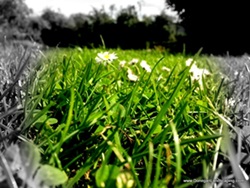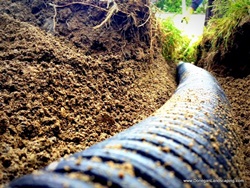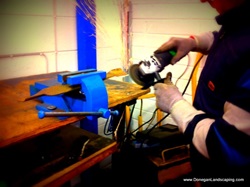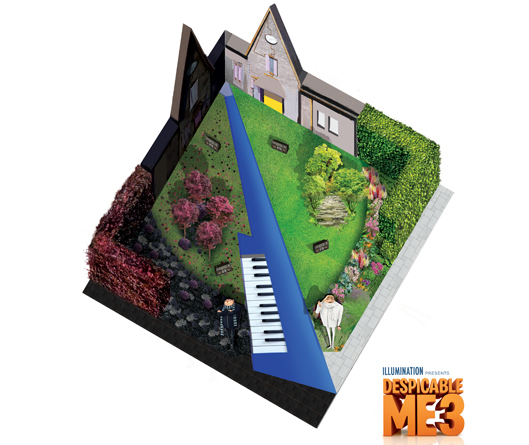
I’ve a few case examples in mind as I type these notes and all lawns are in the process of being treated as we speak. That said if you live in Ireland or the UK and own any form of a grass patch that is not perfect, then a tenner says you’ll find your dilemma and solution noted here. Go grab yourself a cuppa and come back, this is a long one. Also any hassles or queries, leave me a comment below or drop me a line. I’ll pop my details in at the end of the post.

Back to it, the names noted below are not the persons real name and their stories go as follows:
- Bobby: 1 matey type neighbour type mate who suggested he needed a new lawn. In reality, he very simply never cut it for a plethora of months. Lets say 6 of them for the craic. And then he did cut it and then it looked a bit rubbish.
- Problems included hollows in the lawn, far too many weeds, yellow blotches/ old tufty growth and it generally looking like an old patch work quilt.
- Sue-Ellen: A new and fully landscaped garden. Though it was considered, it didn’t get a new lawn as it was decided to spend the budgeted dollars on secksy-er stone. For the long-term, a very smart move. In the short-term, the lawn didn’t look great.
- Problems included too much moss, broad leaf weeds and overall it just looked rather dull and patchy.
- Pam: A newly landscaped garden, where there existed prior to serious drainage problems. The bi-product of this was of course a lawn that was neglected for ages and looked a bit cack. It’s getting there. A new lawn, rolled or other was not an option as its the summer time and they’ve a family that wanna use it. Pam at the same time also wanted it to look good. Problems included water logging, yellowing and white growth from not seeing the light/ being too tall/ never being cut and a mahoosive amount of weeds growing in it.
To prevent repetition, before I refer to any of the above there are a few main headlines that need to be referred to first.
Weeds:

I’ll bet my dinner on it and guaranteed the weeds in your lawn are clover, buttercup, creeping thistle or daisy. There may be others, but that’ll do for now. Either or, all are low growing broad leaf plants and able to bury themselves lower than the height at which you cut your grass. Plants, though they may be weeds in this case are pretty smart when it comes to survival.
Anything taller than this, like a dock for eg. would be eliminated when you run your mower over the lawn ~ in the case of the dock, its nature is to grow as tall as possible, as versus a habit wishing to grow flat and ground covering. More specifically the first sets of leaves are placed higher up the stem and a stem without foliage in short eliminates photosynthesis.
Treatment – One can remove the weeds by hand. Or one can spray with a ~ get ready for it ~ semi selective translocated herbicide. Translated, a weed killer that only attaches to round shaped foliage; eg. daisy, clover etc. Or in this case the weeds in your lawn. What it cannot do by its molecular make up is attach itself to a narrow leaf ~ In this case, the grass makes up your lawn.
The aftermath is that you will end up with bald patches in your lawn. I’ll get to solving that in a minute.
Moss:

Like selling plasters to a haemophiliac, what the horticultural problem solving companies never tell you is how to prevent the moss from ever returning again. And every summer, their bag of miraculous powered stuff re-appears on our tv screens; alongside that fence painting dude who has a neighbour who is painting his by hand. A lot of it is clap trap. And moving swiftly onwards….
Moss in your garden comes as a result of water/ moisture sitting on a surface in a space where gets to sit still. In 99.9% of cases it is because:
your drainage is brutal – the water cannot drain away fast enough and therefore sits still upon/ at the surface of the soil.
your garden is shaded – little/ no sunlight hits your lawn. Of note with sunlight logically comes warm air. The plants that shade your space prevent the movement of the afore-mentioned warm air. Thus, the water/ moisture sits still upon the surface.
For the average non-wimbledon lawned household, a fine tooth rake head and a half an hour exercise will remove the moss in your lawn better than any super dooper product out there on the market.
The aftermath is that you will end up with bald patches in your lawn. I’ll get to solving that in a minute.
Fertiliser:
In most cases I come across – that’s generally when there’s a serious problem – I’d rather someone didn’t fertilise their lawn than did. And unless you own a farm and cattle, please for Gods sake stay away from the 10:10:20 and the bag of fertiliser some fella gave you down at The Rovers Return. I really don’t care if you can get it for free.
Re fertilisers for your lawn please note:
- little and often. And only if required.
- Never, sure I’ll spread the whole bag and that’ll save me doing it next month.
- like giving a 2 year old child red bull and coffee for brekkie, there are side effects to too much of anything. In your lawns case, it will cause a chemical imbalance of nutrients and further problems.
- Old style fertilisers can be leached through the soil after a good lashing of Irish rainfall. Chances of this are quite high as you can gather and timing is everything.
- Two applications of a slow release fertiliser should do you for the full season.
Compaction and Patches:
In your average back garden, a good garden fork, some compost, a little fertiliser and some grass seed should solve most of your problems. Fork it at 1.5″ approximate intervals, brush in the compost and scatter some seed and fertiliser on top. It’s all about air movement, porosity, drainage and that assisting the plants [in this case grass] root development. How effective is it ? In reality, you are only replicating what the big boys do down at my local pitch and putt club/ golf club when they treat the greens – also a lawn. Press play on the video below.
Alternate Options – A New Rolled Turf Lawn:
In all but Pam’s case, assuming there lived in the shed a very generous leprechaun a new rolled lawn could have gone in. What one should appreciate is that when new rolled lawns are laid, fresh and proper, the top layer of soil and the turf are very like walking on the top of a cheese cake ~ very soft so that the root hairs can teeth into it. And it should be that way. But one really shouldn’t walk on it for about 2 weeks odd, if not more.
More important than that, is if you have not solved the underlying problems of drainage or shading for example, then the problems will return to meet and greet your new lawn. In short you, or I on your behalf are simply papering over the cracks.
Lawn Mowers:

I’m not mad on the flymo type mowers as the cut can be really tight to the butt. And far better for a really small space is one of the old school style manual push mowers.
Petrol machine in mind and used correctly ie. rugular mowing, a really decent mulching mower is possibly the finest investment you will ever make – they are also the only type I use. The advantages are that grass clippings are very high in phosphorus and potassium which encourages new growth and flowering and there is no collection of grass. Which leaves more time for you to hide in the shed. It also saves on petrol.
My two cents: buy once, buy right and get the machine serviced once a year. A sharp cutting blade and a well oiled machine is an absolute must. And please for Gods sake, don’t go and do the 129 euro bargain mower thing and get some pile of rubbish. They are usually that price for good reason and you get what you pay for et cetera, et cetera.
The Solutions:
Bobbys Lawn – Bobby really needed to get his lawn mower groove on. Minimum requirement, regular cutting. It was the not doing that that resulted in the yellow/ white tufty stumps of hardened grass – they as plants simply got old and aged. Following that a slow release fertiliser was applied and on the same day his lawn was sprayed with a semi selective herbicide. He’ll leave that for about 7 – 12 days depending on temperatures and rainfall and then get back to regular cutting.
After that, he’s got around 4 places of approximate 1′ diameter where the level of the soil was about 2-3 inches below the level of the rest. In short, he had some bumps and hollows. Here it will be a simple case of a bag of compost, bring the lawn up to level and then sow some seed with a pre-emergent fertiliser.
Sue-Ellen’s Lawn – except for the fact that it wasn’t neglected for an elongated period of time Sue Ellen had exactly what Bobby had and her lawn treated in exactly the same way, as noted above. Sue-Ellen also had however a really bad moss problem.
Considering there never existed a garden there before; she’s not a gardener; she doesn’t own an elephant – note compaction; and the fact that I dug a few test holes, I know that the under-lying problem was not drainage. That said her garden was surrounded by neighbouring trees that shaded the space a lot and they have now been removed.
Pams Lawn – drainage pipes were installed into the lawn. this will solve the moss, water logging and there are now no recent weather excuses for irregular mowing. The overgrowth was strimmed. Raked off. Cut at the highest height. Then raked again and cut…. over and over until I got it to what was ‘normal’ grass level. After that, simplified, it got a some fertiliser to give it a wee boost and regular cutting should look after the rest, for now.
Further Notes:
- I’ve shortened some of the processes above more so that this post does not turn into a book. Any Q’s just pop me a comment below.
- The return to ‘normal’ will take time, patience and regular observation.
- Grass likes typical Irish weather conditions. Think of Irish people sunbathing and the patchy white and sunburn brown. In short lots of rain and a little heat.
- Grass growing temperatures are about 12- 14 celsius.
- Semi-selective weed killers form a distortion in the growth cells of the plant. Below 12 celsius ie. as the plant is not growing, the herbicide is pretty much inactive.
- Grass seed wil grow in the cracks of your paving and gutters. It will do a heck of a lot better if sown in a suitable growing medium.
- By regular cutting I refer to every 5 – 7 days. Weather conditions will of course cause this to vary.
Peter Donegan:
email: info@doneganlandscaping.com
phone: +353(87)6594688
twitter: @DoneganGardens
facebook: DoneganLandscaping
Source: Peter Donegan Landscaping – Grass Problems and Lawn Repair





